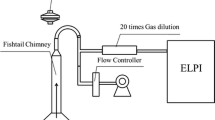Summary
The metabolite of E, EO, has been shown to be an extrahepatic carcinogen in rats in long-term studies. By means of a rat liver foci bioassay with 3 to 4 days old Sprague-Dawley rats, EO showed an initiating capacity in the livers of female, but not of male rats, measured as incidence of foci deficient in ATPase. After inhalation of 55 and 100 ppm EO, 8 h daily, 5 days weekly, and over 3 weeks, 1 week of pause, and another 8 weeks of promotion with polychlorinated biphenyls, foci incidence was generally low. But it was concentration dependently higher than in controls 12 weeks after starting the experiment. A linear concentration-effect relationship existed with cocorrelation coefficient of r=0.991. With 33 ppm EO the number of foci was not enhanced significantly. The administration 10000 ppm E did not result in an enhanced foci incidence. In general the carcinogenic potential of EO, which has not been shown so far to cause hepatic tumors in rats. could be demonstrated in rat liver using a sensitive rat liver foci bioassay.
Similar content being viewed by others
Abbreviations
- EO:
-
ethylene oxide
- E:
-
ethylene
- ATPase:
-
adenosine-5′-triphosphatase (EC 3.6.1.3)
- GGTase:
-
gamma-glutamyltranspeptidase (EC 2.3.2.2.)
References
Bolt HM, Filser JG, Störmer F (1984) Inhalation pharmacokinetics of ethylene and 1,3-butadiene in rats. Arch Toxicol 55:213–218
Bolt HM, Filser JG (1987) Kinetics and disposition in toxicology. example: Carcinogenic risk estimate for ethylene. Arch Toxicol 63 (in press)
Calleman CJ, Ehrenberg L, Jansson B, Osterman-Golkar S, segerbäck D, Svensson K, Wachtmeister CA (1978) Monitoring and risk assessment by means of alkyl groups in haemoglobin in persons occupationally exposed to ethylene oxide. J Environ Pathol Toxicol 2:427–442
Deml E, Oesterle D, Wiebel FJ (1983) Benzo(a)pyrene initiates enzyme-altered islands in the liver of adult rats following enzymealtered islands in the liver of adult rats following single pretreatment and promotion with polychlorinated biphenyls. Cancer Lett 19:301–304
Filser JG, Bolt HM (1979) Pharmacolinetics of halogenated ethylenes in rats. Arch Toxicol 42:123–136
Filser JG, Bolt HM (1983) Exhalation of ethylene oxide by rats on exposure to ethylene. Mutat Res 120:57–60
Filser JG, Bolt HM (1984) Inhalation pharmacokinetics based on gas uptake studies. VI. Comparative evaluation of ethylene oxide and butadiene monoxide as exhaled reactive metabolites of ethylene and 1,3-butadiene in rats. Arch Toxicol 55:219–223
Garman RH, Snellings WM, Maronpot RR (1985) Brain tumors in F344 rats associated with chronic inhalation exposure to ethylene oxide. Neurotoxicology 6:117–138
Hamm TE, Guest D, Dent JG (1984) Chronic toxicity and oncogenicity bioassay of inhaled ethylene in Fischer 344 rats. fundam Appl Toxicol 4:473–478
IARC monograph on the evaluation of the carcinogenic risk of chemicals to humans (1985) Allyl compounds, aldehydes, epoxides and peroxides, vol 36 International Agency for Research on Cancer. Lyon, pp 189–226
Lynch DW, Lewis TR, Moorman WJ, Burg JR, Groth DH, Khan A, Ackerman LJ, Cockrell BY (1984) Carcinogenic and toxicologic effects of inhaled ethylene oxide and propylene oxide in F344 rats. Toxicol Appl Pharmacol 76:69–84
Oesterle D, Deml E (1983) Promoting effect of polychlorinated biphenyls on development of enzyme-altered islands in livers of weanling and adult rats. J Cancer Res Clin Oncol 105:141–147
Osterman-Golkar S, Farmer PB, Segerbäck D, Calleman CJ, Bailey E, Svensson K, Ehrenberg L (1983) Dosimetry of ethylene oxide in the rat by quantitation of alkylated histidine in hemoglobin. Teratogenesis Carcinog Mutagen 3:395–405
Segerbäck D (1983) Alkylation of DNA and hemoglobin in the mouse following exposure to ethene and ethene oxide. Chem Biol Interact 45:139–151
Snellings WM, Weil CS, Maronpot RR (1981) Final report on ethylene oxide two-year inhalation study on rats. Project report 44-20, Bushy Run Research Center (formerly Carnegie-Mellon Institute of Research), January 28, 1981. Submitted by Union Carbide Corporation to the US Environmental Protection Agency under Section 8(e) of the toxic Substances Control Act, on behalf of cosponsors of the study
Tsuda H, Lee G, Farber E (1980) Induction of resistatn hepatocytes as a new principle for a possible short-term in vivo test for carcinogens. Cancer Res. 40:1157–1164
Author information
Authors and Affiliations
Additional information
Dedicated to Professor Werner Kunz on the occasion of his 65th birthday
Supported by grants from Umweltbundesamt, Berlin (UBA 10606043)
Rights and permissions
About this article
Cite this article
Denk, B., Filser, J.G., Oesterle, D. et al. Inhaled ethylene oxide induces preneoplastic foci in rat liver. J Cancer Res Clin Oncol 114, 35–38 (1988). https://doi.org/10.1007/BF00390483
Received:
Accepted:
Issue Date:
DOI: https://doi.org/10.1007/BF00390483




